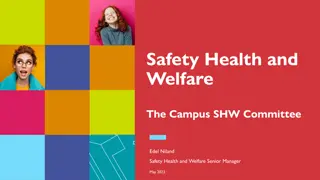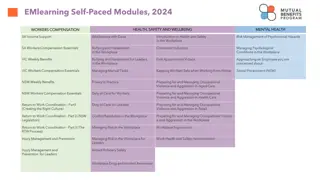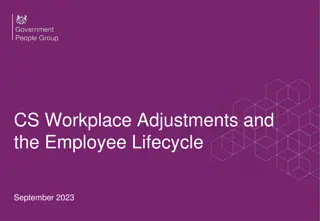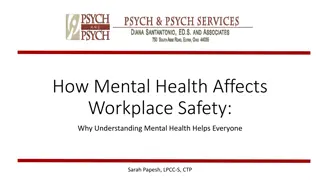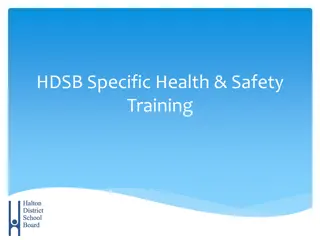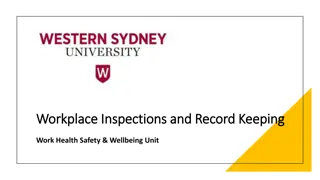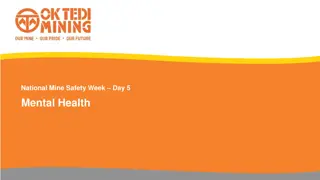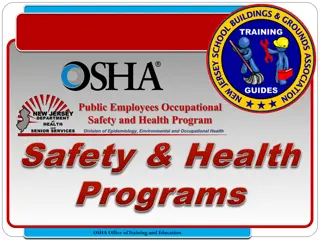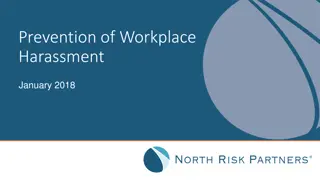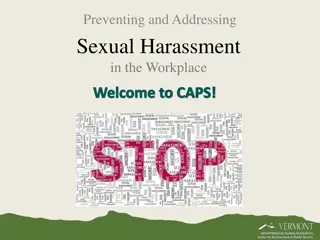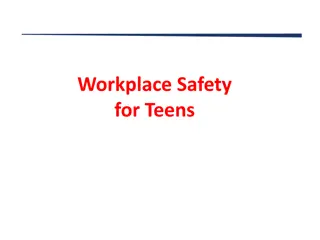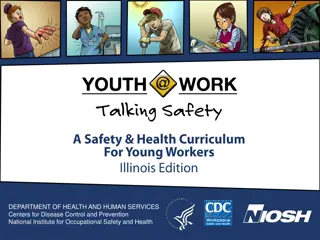Importance of Workplace Health and Safety Laws
Preventing workplace injuries and promoting a safe environment is crucial for employees and employers. Ontario's laws ensure protection, set out responsibilities, and establish general health and safety requirements in workplaces. The Internal Responsibility System (IRS) outlines duties for workers, supervisors, employers, and representatives. The Ontario Ministry of Labour enforces the Occupational Health and Safety Act which includes penalties for violations. Compliance with health and safety regulations is essential to avoid fines and legal consequences.
Download Presentation

Please find below an Image/Link to download the presentation.
The content on the website is provided AS IS for your information and personal use only. It may not be sold, licensed, or shared on other websites without obtaining consent from the author.If you encounter any issues during the download, it is possible that the publisher has removed the file from their server.
You are allowed to download the files provided on this website for personal or commercial use, subject to the condition that they are used lawfully. All files are the property of their respective owners.
The content on the website is provided AS IS for your information and personal use only. It may not be sold, licensed, or shared on other websites without obtaining consent from the author.
E N D
Presentation Transcript
The Ontario government has laws to protect the health and safety of workers. This is why preventing workplace injuries is important for everyone. The purpose of these laws is to prevent injury and illness which helps create a better place to work. Along with specific duties and responsibilities, the law also sets out general health and safety requirements for everyone in the workplace.
Who are the members? Where are their locations in the building? (if applicable)
List your committee members here (if applicable)
Protects employees and the employer from death or injury. Teachesworkers how to work in a safe environment. Helps everyone feel safe and happy. Teachesthe workers to pay attention to their surroundings. Protects companies from law suits, citations and fines.
The Lawsets out: Your rights and responsibilities as a worker Your responsibilityas a supervisor and employer The role of the government in enforcing the law Specific regulations for certain jobs or workplaces Under the law, everyone has a role to play in preventing workplace injuries and illnesses. This means, workers, supervisors, employers, and worker representatives all have legal duties to keep their workplace safe and healthy. This system of health and safety duties is called the Internal Responsibility System (IRS). Every employee must be trained on the Health & Safety in their workplace.
The Ontario Ministry of Labour (MOL) enforces the Occupational Health and Safety Act (OHSA) and its regulations. MOL inspectors can enter any workplace covered by the OHSA at any time! The MOL can also: Lay charges against companies or people breaking the law Inspect workplaces Issues orders and stop unsafe work Investigate serious accidents, fatalities, or work refusals Look for violations of health and safety laws and regulations When health and safety laws are broken, there are penalties to pay. A person can be fined up to $25,000 for every charge laid under the OHSA and/or serve 12 months in jail. A corporation can be fined up to $500,000 for each violation if convicted.
Inspect the workplace at least once a month. Identify workplace hazards. Be consulted about workplace testing and make recommendations to the employer. Investigate work refusals and serious accidents. Carry out regular inspections of the workplace. Be available to receive worker concerns, complaints, and recommendations; discuss problems and recommend solutions; and to provide input into existing and proposed health and safety programs.
Workers must: Follow the law and workplace health and safety policies and procedures. Wear and use the protective equipment required by their employer. Work and act in a way that won t hurt themselves or anyone else. Report any hazards or injuries to their supervisor.
As a worker, the law also give you three important rights: 1. The Right to Know 2. The Right to Participate 3. The Right to Refuse Unsafe Work
You have a right to know about dangers in your workplace and what to do about them. Your employer must provide you with the training, supervision and hazard information you need to perform your job safely.
You have the right to take part in keeping your workplace healthy and safe. Ask questions Help with health and safety inspections Take part in training Identify hazards and possible solutions
When the boss or supervisor tells you to do something, it s hard to say no. But you should say no if you think someone will get hurt. No job is worth getting injured. Before refusing work that you think is dangerous, discuss it with your boss or supervisor. In most cases, your can work it out. But if your boss insists that you do work that you feel is unsafe, you may have to refuse. If you do need to refuse, be polite but firm.
STEP ONE: If you decide to refuse a task because you think it is unsafe, you must report your refusal to your supervisor or employer. STEP TWO: Your supervisor or employer will call in your worker health and safety representative. STEP THREE: Your supervisor or employer must investigate your concern in front of both you and the worker representative. If your supervisor or employer agrees that the work is dangerous, and it is corrected, you can return to work. STEP FOUR: In most cases, you your supervisor, and your worker representative will be able to solve the problem. But if you can t resolve the issue and you feel you have reasonable grounds to continue refusing, the Ministry of Labour can be called by the employee. The MOL inspector will investigate and help correct the problem. While you wait for the inspector s investigation, your employer can give you other reasonable work to do.
Employers must: Make sure workers know about hazards and dangers by providing information, instruction and supervision on how to work safely. Make sure supervisors know what is required to protect workers health and safety on the job. Create workplace health and safety policies and procedures. Make sure everyone follows the law and the workplace health and safety policies and procedures. Make sure workers wear and use the right protective equipment. Do everything reasonable in the circumstances to protect workers from being hurt or getting a work-related illness.
A workplace hazard is any condition, practice, behaviour, or a combination of these that can cause injury or illness to a person or damage to property.
They are generally grouped into four basic types: PHYSICAL HAZARDS include unsafe machines and environmental condition. Examples are unguarded machine parts like saw blades, constant noise, or prolonged exposure to sun or cold. BIOLOGICAL HAZARDS are produced by living things. They often come from working with animals and people. Examples include blood, viruses and animal and bird droppings. CHEMICAL HAZARDS include materials that are flammable, explosive or poisonous. Example are cleaning products, pesticides and gasoline. ERGONOMIC HAZARDS are caused by poorly designed workplaces or processes. Examples are poor lighting, workstations that are too high or low for you or a job that requires you to repeat the same movement over and over.
NOISE is unwanted sound that can interfere with communications in the workplace, leading to possible injuries. Excessive noise levels or prolonged noise can damage the nerves in the ear. Hearing loss may be temporary or permanent. Effects: Hearing loss Ringing in the ears Difficulty in understanding what people say Sleep problems Fatigue Muscle tension
Frayed electrical cords, missing ground pins, improper wiring and live electrical parts can all result in electric shock. Death from electrocution Burns to skin and organs
BACTERIAare found in the air, water, soil, and in living or dead animals or plants. VIRUSESare micro-organisms that reproduce by coming into contract with living cells. They are found only in living animal and plant matter. FUNGIare simple plants that feed on the living or dead tissues of animals or plants. Mold, mushrooms and yeast are examples of fungi.
Some hazards like slippery floors or building water cause injuries right away. But other hazards take longer. Immediate injuries are called acute. Examples of acute injuries are burns, fractures or bruises. Illnesses that develop over a long period of time are called chronic. Examples of chronic illnesses include repetitive strain, hearing loss and cancer.
Falls from even minor heights can result in critical injuries or death Broken Bones Muscle strains Death
The goal of ergonomics is to improve the "fit" between the worker and the workplace activities. This is accomplished by improving the set-up of workstations, improving the tools and equipment used to perform work tasks, and adapting the way the work is done.
Work Stations and Tools Adjust your workstation and seat to meet your needs Maintain a neutral, relaxed posture, and work in a comfortable position Use tools and equipment that reduce repetition, awkward, or sustained postures, forceful muscle movements and pressing on hard surfaces
http://www.youtube.com/watch?v =v4v7CXDBTxk VIDEO
Take a balanced stance - put your feet shoulder width apart. Get close to the object and squat down to pick up the load. Get a secure grip and carry the load close to your body. Test the weight of the load before trying to lift it. Lift the load gradually and smoothly, keeping your back and neck straight. Turn your whole body when carrying a load, instead of twisting your back. Follow these instructions in reverse when lowering a load. And Remember Do not work until you become sore or tired report any discomfort to your supervisor
http://www.youtube.com/watch?v= NgKEidZynfM VIDEO


